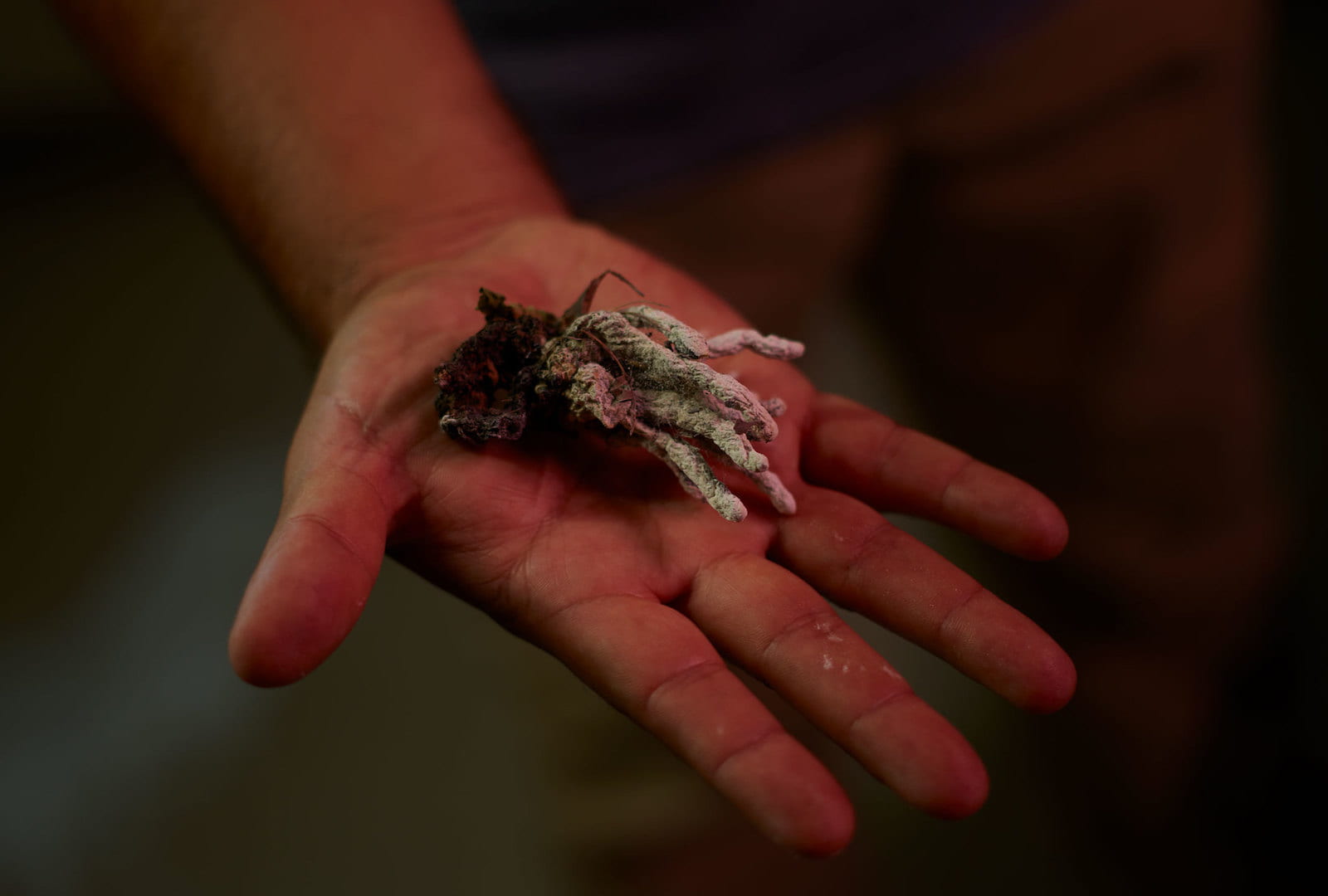Cover Crop Study Shows Potential to Limit Taproot Decline Disease in Soybeans

The stromata of an emerging soybean pathogen resembles those of other fungi that are also known as “dead man’s fingers.” (Photo by Arkansas Agricultural Experiment Station)
The Problem
Xylaria necrophora, a pathogenic fungus sometimes called “Dead Man’s Fingers,” has the potential to inflict substantial damage to soybean plants as the causal agent of taproot decline disease. The fungus has become more prominent in soybean fields where there has been no crop rotation for many years. A multi-disciplinary team of researchers with the University of Arkansas System Division of Agriculture has worked to limit the spread of the disease using cover crops. They are also studying the fungi’s genetics to better understand the disease and help soybean breeders develop less susceptible soybean cultivars.
Terry Spurlock, associate professor and extension plant pathologist with the Division of Agriculture, said Xylaria necrophora so far has not been a serious problem for Arkansas soybean farmers outside of Chicot, Desha and Jefferson counties. However, the pathogen has been observed in some fields that have been rotated from corn to soybean, a common practice of many farmers. Since it is a relatively new pathogen, research on management options has been limited.
The Work
Xylaria necrophora was pinpointed by Spurlock and several other researchers in 2014 as the culprit of taproot decline, which was widely misdiagnosed for several years and mistaken for other diseases like Soybean Sudden Death Syndrome. Soybean taproot decline caused by Xylaria necrophora is also found in Alabama, Louisiana, Mississippi, and Tennessee.
Cultivar screening and seed treatments have been assessed as strategies to manage taproot decline. However, other cultural practices such as crop rotation and enhancement of soil health by using cover crops are thought to have the potential to change the environment where this disease occurs and minimize its incidence.
To test the hypothesis, eight cover crops were evaluated in greenhouse assays in 2019 and 2020 by Division of Agriculture researchers to see which was best at outcompeting Xylaria necrophora to reduce the chances of it infecting the next year’s soybean crop.
The cover crop study investigated the susceptibility of wheat, barley, rye, mustard, black oat, vetch, winter pea, and blue lupine as cover crops, along with the Xylaria-susceptible soybean Hutcheson. Additionally, field trials are underway to assess the role of cover crops as a taproot decline management tool.
Division of Agriculture pathologist Alejandro Rojas and his research associate, Qiurong Fan, have collected Xylaria samples from soybean fields around Arkansas to find out which soybean varieties are the most susceptible, and tolerant, to the pathogen. They have found 10 non-pathogenic and 30 pathogenic isolates of Xylaria in Arkansas. The pathologists are also using novel genomic tools to generate a complete genome of Xylaria and produce resources to understand the emergence of the soilborne pathogen.
The Results
Out of the eight cover crops evaluated, cereal rye showed a potential to reduce taproot decline disease. Barley and oats were the most susceptible at the seed level to Xylaria necrophora. The study also found that cover crops at the seedling level were less susceptible, but mustard and radish had the greatest reduction at root mass. Some of the cover crops like rye and winter pea had reduced root damage, Rojas said. The cover crop study provides insight into how the fungus survives from one growing season to the next.
Field and greenhouse assays will be conducted to further explore the interaction of Xylaria with different soil types and evaluate detection methods for the pathogen.
The Value
With this study, the Division of Agriculture researchers developed further understanding of the cover crop susceptibility to Xylaria necrophora, as well as a long-term survival strategy of the pathogen in soil using cover crops as rotation crops. They also developed more information to help with cover crop species selection to reduce disease pressure on soybean plants.
Soybeans generate about $1.7 billion annually in cash receipts for Arkansas farmers. The commodity is grown in more than half of the state’s 75 counties. In 2021 there were over 3 million acres of soybeans planted in Arkansas.
Desha County, one of the three counties in Arkansas which has experienced the highest severity of “Dead Man’s Fingers” in soybean fields, has been among the top five soybean producing counties in the state, according to the Arkansas Soybean Research Studies 2019. Desha County and the four other counties – Mississippi, Arkansas, Crittenden and Poinsett – accounted for more than 35 percent of the soybean production in Arkansas in 2019.
Developing a better understanding of taproot decline and its causal agent Xylaria necrophora will be key to developing better management practices to fight the disease and prevent soybean yield loss.
Funding
Arkansas Agricultural Experiment Station and the Arkansas Soybean Promotion Board
About the Researchers

Terry Spurlock
Associate Professor and Extension Plant Pathologist
Ph.D. – University of Arkansas (Plant Science)
M.S. – University of Arkansas (Plant Pathology)
B.S. – Texas A&M University (Agronomy)
Spurlock’s primary research interest lies in deconstructing all abiotic and biotic stresses within a given agriculture system to determine the factors associated with yield loss and economic impact of both soil-borne and foliar diseases using the latest remote sensing technologies as well as traditional laboratory assays. His laboratory is involved in the evaluation of fungicides and nematicides for products labeled in Arkansas as well as those in various stages of development from industry partners.

Alejandro Rojas
Assistant Professor of Entomology and Plant Pathology
Ph.D.- Michigan State University, East Lansing (Plant Pathology and Ecology, Evolutionary Biology and Behavior)
M.S. – Michigan State University, East Lansing (Plant Pathology)
B.S. – Los Andes University, Bogotá, Columbia (Microbiology)
Rojas’ research focuses on the interaction of plant and root-associated microorganisms and their effects on plant growth and health. These include the interaction between fungal and oomycete pathogens, fungal endophytes, and other guilds that are present in agricultural and natural ecosystems. His team’s goal is to understand the biology, ecology, and epidemiology of soilborne and plant-associated fungi and oomycetes to minimize their negative impact on food production and promote plant health, which in turn results in higher crop yields.


